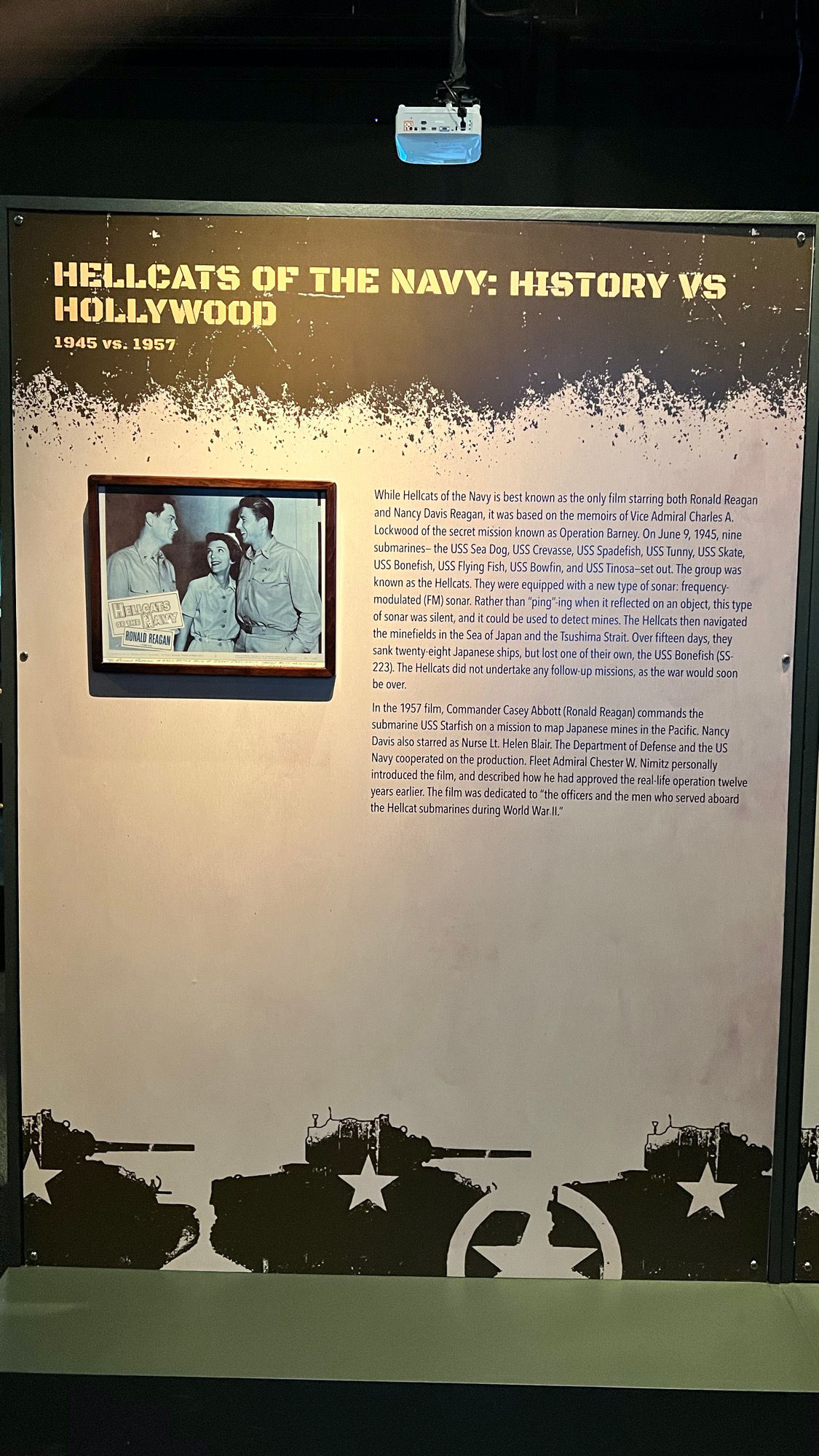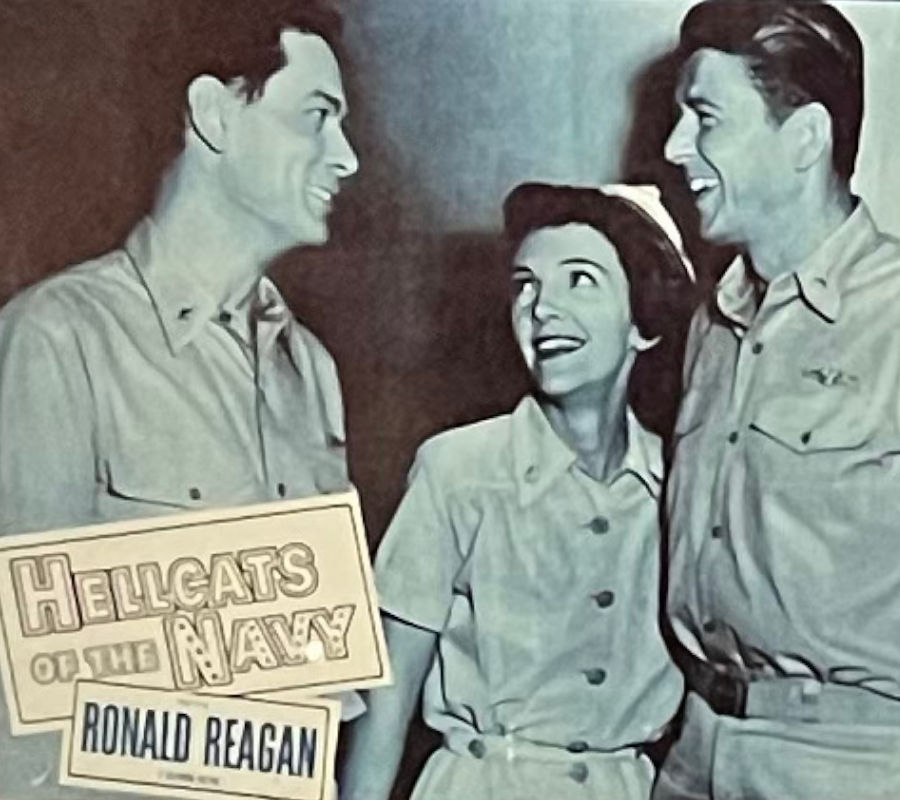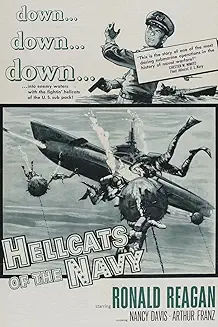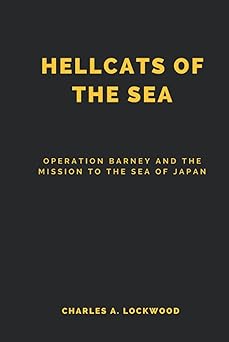The USS Wahoo Submarine (SS-238) was sunk in October 1943 while returning home from a patrol in the Sea of Japan. The US decided that the Japanese must have mined the Sea of Japan so heavily that it could no longer be patrolled. Then frequency-modulated (FMS) sonar was invented. It showed the location of mines on an electronic screen and at contact emitted a chime that was nick named "Hell's Bells".
On June 9, 1945, nine submarines equipped with FMS sonar set out to deal with the Sea of Japan. They were called the Hellcats. Over fifteen days, they sank twenty-eight Japanese ships, but lost one of their own, the USS Bonefish (SS-223).

1945 vs. 1957
While Hellcats of the Navy is best known as the only film starring both Ronald Reagan and Nancy Davis Reagan, it was based on the memoirs of Vice Admiral Charles A. Lockwood of the secret mission known as Operation Barney. On June 9, 1945, nine submarines - the USS Sea Dog, USS Crevasse, USS Spadefish, USS Tunny, USS Skate, USS Bonefish, USS Flying Fish, USS Bowfin, and USS Tinosa - set out.
The group was known as the Hellcats.
- They were equipped with a new type of sonar: frequency-modulated (FM) sonar.
- Rather than "ping"-ing when it reflected on an object, this type of sonar was silent, and it could be used to detect mines.
- The Hellcats then navigated the minefields in the Sea of Japan and the Tsushima Strait.
- Over fifteen days, they sank twenty-eight Japanese ships, but lost one of their own, the USS Bonefish (SS-223).
- The Hellcats did not undertake any follow-up missions, as the war would soon be over.
In the 1957 film

- Commander Casey Abbott (Ronald Reagan) commands the submarine USS Starfish on a mission to map Japanese mines in the Pacific.
- Nancy Davis also starred as Nurse Lt. Helen Blair.
- The Department of Defense and the US Navy cooperated on the production.
- Fleet Admiral Chester W. Nimitz personally introduced the film, and described how he had approved the real-life operation twelve years earlier.
- The film was dedicated to "the officers and the men who served aboard the Hellcat submarines during World War II."
WIKIPEDIAHellcats of the Navy
1957 American black-and-white World War II submarine film
From Columbia Pictures, produced by Charles H. Schneer and directed by Nathan Juran. The film stars Ronald Reagan and his wife, billed under her screen name Nancy Davis, and Arthur Franz. This was the only feature film in which the Reagans acted together, either before or after their 1952 marriage.The film's setting is the Pacific War. The film's storyline concerns Commander Casey Abbott, skipper of the submarine USS Starfish, being ordered to retrieve a new type of Japanese mine in the waters off the Asiatic mainland. When diver Wes Barton, Abbott's rival for the affections of Nurse Lieutenant Helen Blair, gets into a life-threatening situation, Abbott must keep his personal and professional lives separate when dealing with the crisis.
The story is based on the 1955 non-fiction book Hellcats of the Sea by Vice Admiral Charles A. Lockwood and Hans Christian Adamson.
Commander Casey Abbott (Ronald Reagan), commander of the submarine USS Starfish, is ordered to undertake a dangerous mission which sees him attempting to cut off the flow of supplies between China and Japan in the heavily mined waters off the Asiatic mainland. When a diver, who is Abbott's competitor for the affections of nurse Lieutenant Helen Blair (Nancy Davis) back home, gets into a dangerous situation, Abbott must struggle to keep his personal and professional lives separate in dealing with the crisis.
The results arouse ill feelings in the crew and especially Abbott's executive officer, Lt. Commander Landon (Arthur Franz), who asks his captain to let him air his views in confidence. The results lead Abbott to write in Landon's efficiency report that he should never be given command of a naval vessel, resulting in further ill will between the two.
Hellcats of the Sea
- by Lockwood, Charles A., 1890-1967; Adamson, Hans Christian, joint author
- Publication date 1955
- Topics World War, 1939-1945, World War, 1939-1945, World War, 1939-1945, Operation Barney, 1945
- Publisher New York, Greenberg
- Collection inlibrary; printdisabled; internetarchivebooks
- Contributor Internet Archive
- Language English
WIKIPEDIAUSS Wahoo (SS-238)
Gato-class submarine, the first United States Navy ship to be named for the wahoo. Construction started before the U.S. entered World War II, and she was commissioned after entry. Wahoo was assigned to the Pacific theatre. She gained fame as an aggressive and highly successful submarine after Lieutenant Commander Dudley Walker "Mush" Morton became her skipper. She was sunk by Japanese aircraft in October 1943 while returning home from a patrol in the Sea of Japan.Seventh patrol and loss, September–October 1943
Morton, smarting from that last luckless patrol, asked to return to the Sea of Japan, and permission was granted. He elected to take a full load of the newly arrived Mark 18 electric torpedo rather than take the risk that further production runs of the Mark 14 steam torpedoes might still be defective. Wahoo got underway from Pearl Harbor, topped off fuel and supplies at Midway on 13 September, and headed for La Perouse Strait. The plan was to enter the Sea of Japan first, on or about 20 September, with Sawfish following by a few days. At sunset on 21 October, Wahoo was supposed to leave her assigned area, south of the 43rd parallel, and head for home. She was instructed to report by radio after she passed through the Kurils. Nothing further was ever heard from Wahoo.On 25 September 1943 the Taiko Maru was torpedoed in the Sea of Japan; mistakenly credited to the USS Pompano (SS-181), it was apparently sunk by Wahoo.
On 5 October, the Japanese news agency Domei announced to the world that a steamer, the 8,000 long tons Konron Maru, was sunk by an American submarine off the west coast of Honshu near Tsushima Strait, with the loss of 544 lives. The victims included two Japanese congressmen of the House of Representatives, Choichi Kato and Keishiro Sukekawa. Postwar reckoning by JANAC showed Wahoo sank three other ships for 5,300 tons, making a patrol total of four ships of about 13,000 long tons. The sinking of Konron Maru enraged the Japanese navy, and the Maizuru Naval District ordered a 'search and destroy' operation for US submarines.
Japanese records also reported that on 11 October, the date Wahoo was due to exit through La Perouse Strait in the morning, Wahoo was bombarded from Cape Sōya. An antisubmarine aircraft (likely an Aichi E13A floatplane) sighted a wake and an apparent oil slick from a submerged submarine. The Japanese initiated a combined air and sea attack with numerous bombs and depth charges throughout the day. Sawfish had been depth-charged by a patrol boat while transiting the strait two days before, and the enemy's antisubmarine forces were on the alert; their attacks fatally holed Wahoo, and she sank with all hands. She was declared overdue on 2 December 1943 and stricken from the Naval Vessel Register on 6 December 1943.
After the loss of Wahoo, no US submarines ventured into the Sea of Japan until June 1945, when special mine-detecting equipment became available.
Wahoo earned six battle stars for World War II service.
In 2005, electronic surveys in the region yielded what turned out to be a U.S. Gato-class submarine in the Strait; in July 2006, the Russian team "Iskra" investigated the site which contributed further evidence of location of Wahoo. On 31 October 2006, the U.S. Navy confirmed that the images provided by the "Iskra" team are of Wahoo, the wreckage lying intact in about 213 ft (65 m) of water in the La Perouse (Soya) Strait. The submarine was sunk by a direct hit from an aerial bomb near the conning tower.
WIKIPEDIAUSS Bonefish (SS-223)
Gato-class submarine, the first United States Navy ship to be named for the bonefish. She had a busy career in the Pacific against Japanese shipping after being launched and commissioned in May 1943. She was sunk in June 1945 after sinking a ship on her eighth cruise.Upon completion of refit on May 28 May, Bonefish got underway in company with Tunny (SS-282) and Skate (SS-305), as part of "Pierce's Pole Cats", commanded by Tunny's skipper, Commander George E. Pierce. Equipped with a new mine-detecting device, the submarines were ordered to penetrate the Sea of Japan to sever the last of the Japanese overseas supply lines. Bonefish successfully threaded her way through the minefields by Tsushima Island as she transited the Korea Strait to enter the Sea of Japan for an offensive patrol off the west central coast of Honshu.
During a rendezvous with Tunny on June 16, Bonefish reported sinking Oshikayama Maru, a 6,892 ton cargo ship. In a second rendezvous two days later, she requested and received permission to conduct a daylight submerged patrol of Toyama Bay, a bay farther up the Honshu coast. The attack group was to depart the Sea of Japan via La Perouse Strait on the night of June 24. Bonefish did not make the scheduled pre-transit rendezvous. Still, Tunny waited in vain off Hokkaidō for three days. On July 30, Bonefish was presumed lost.
Japanese records reveal that the 5,488 ton cargo ship Konzan Maru was torpedoed and sunk in Toyama Wan on June 18 and that an ensuing severe counterattack by Japanese escorts, the Okinawa, CD-63, CD-75, CD-158 and CD-207, brought debris and a major oil slick to the water's surface. There can be little doubt that Bonefish was sunk in this action. She was the second to last United States Submarine lost in the war, with Bullhead (SS-332) being lost in August 1945.










